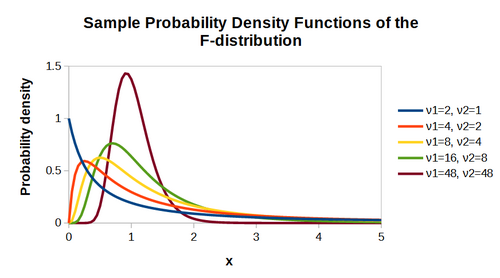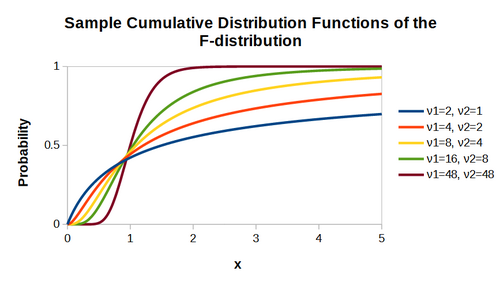Documentation/Calc Functions/F.DIST
TDF LibreOffice Document Liberation Project Community Blogs Weblate Nextcloud Redmine Ask LibreOffice Donate
Function name:
F.DIST
Category:
Statistical Analysis
Summary:
Calculates F-distribution values from either the probability density function or the cumulative distribution function.
F-distributions (named in recognition of Sir Ronald Fisher) are a family of continuous probability distributions on the interval [0, +∞) that often arise in the statistical analysis of variance. The F-distribution has two characteristic parameters, known as the degrees of freedom for the numerator and the degrees of freedom for the denominator and these determine the shape of the distribution.
Syntax:
F.DIST(Number; Degrees freedom 1; Degrees freedom 2[; Cumulative])
Returns:
Returns a non-negative real number, which is the F-distribution value for the given arguments. For the probability density function, the value returned lies in the range [0, +∞). For the cumulative distribution function, the value returned lies in the range [0, 1].
Arguments:
Number is a non-negative real number, or a reference to a cell containing that number, which is the value at which the F-distribution is to be evaluated.
Degrees freedom 1 is a positive integer, or a reference to a cell containing that number, which is the degrees of freedom for the numerator of the F-distribution.
Degrees freedom 2 is a positive integer, or a reference to a cell containing that number, which is the degrees of freedom for the denominator of the F-distribution.
Cumulative is a logical value, or a reference to a cell containing that value, that determines whether the required probability is taken from the probability density function or the cumulative distribution function. If Cumulative is set to 0 or FALSE, a value from the probability density function is calculated. For any other values of Cumulative, or if Cumulative is omitted, a value from the cumulative distribution function is calculated.
- If any of Number, Degrees freedom 1, or Degrees freedom 2 is non-numeric, then F.DIST reports a #VALUE! error.
- If Number is less than 0.0, then F.DIST reports an invalid argument error (Err:502).
- If either Degrees freedom 1 or Degrees freedom 2 is less than 1, then F.DIST reports an invalid argument error (Err:502).
- If either Degrees freedom 1 or Degrees freedom 2 is a non-integer value, then F.DIST truncates it to an integer value.
- When the mathematics is such that it is not possible to calculate a value for the combination of arguments specified, then F.DIST reports a #NUM! error. An example is the formula
=F.DIST(0; 1; 3; FALSE).
Additional details:
- Calc's F.DIST function implements the requirements specified for the FDIST function in Section 6.18.22 of ODF 1.2. Note:
- Calc's FDIST function implements the requirements specified for the LEGACY.FDIST function in Section 6.18.23 of ODF 1.2. Therefore, F.DIST and FDIST are not interchangeable.
- For Calc's F.DIST function, the Cumulative argument is optional (consistent with ODF 1.2). For Microsoft Excel's F.DIST function, the Cumulative argument is required.
- The formula for the probability density function of the F-distribution is given by:
- [math]\displaystyle{ \text{F.DIST}(x;\:ν1;\:ν2; FALSE)~=~ \frac{\Gamma \left( \frac{ν1+ν2}{2} \right) \left( \frac{ν1}{ν2} \right)^\frac{ν1}{2}} {\Gamma \left( \frac{ν1}{2} \right) \Gamma \left( \frac{ν2}{2} \right)} \times \frac{x^{\frac{ν1}{2}-1}} {\left( 1+\frac{ν1}{ν2}x \right)^{\frac{ν1+ν2}{2}}} }[/math]
- where ν1 is the degrees of freedom for the numerator, ν2 is the degrees of freedom for the denominator, and [math]\displaystyle{ \Gamma }[/math] is the gamma function.
- The formula for the cumulative distribution function of the F-distribution is given by:
- [math]\displaystyle{ \text{F.DIST}(x;\:ν1;\:ν2; TRUE)~=~ \frac{\Gamma \left( \frac{ν1+ν2}{2} \right) \left( \frac{ν1}{ν2} \right)^\frac{ν1}{2}} {\Gamma \left( \frac{ν1}{2} \right) \Gamma \left( \frac{ν2}{2} \right)} \times \int_{0}^{x} \frac{t^{\frac{ν1}{2}-1}} {\left( 1+\frac{ν1}{ν2}t \right)^{\frac{ν1+ν2}{2}}}\:dt }[/math]
- The following figure shows probability density function plots for five sample F-distributions.
- The following figure shows cumulative distribution function plots for five sample F-distributions.
- The name space for F.DIST is
COM.MICROSOFT.F.DIST. - For more information about F-distributions, visit Wikipedia's F-distribution page.
Examples:
| Formula | Description | Returns |
|---|---|---|
| =F.DIST(A1; A2; A3; A4) where cells A1:A4 contain the values 0.8, 8, 12, and 0 respectively. | Here the function calculates a value from the probability density function for a specified F-distribution, reading its input argument values from cells. | 0.709528249878683 |
| =F.DIST(0.8; 8; 12; TRUE) | Here the function calculates a value from the cumulative distribution function for a specified F-distribution. Note that the formula =F.DIST(0.8; 8.75; 12.9; TRUE) returns the same value because the non-integer Degrees freedom 1 and Degrees freedom 2 values are truncated. |
0.385660356254188 |
| =F.DIST(0.8; 8; 12) | Here the Cumulative argument is omitted and so its default value of TRUE is applied. The function calculates a value from the cumulative distribution function for a specified F-distribution. | 0.385660356254188 |
Related LibreOffice functions:
ODF standard:
Related (or similar) Excel functions:
F.DIST since v.2010.

